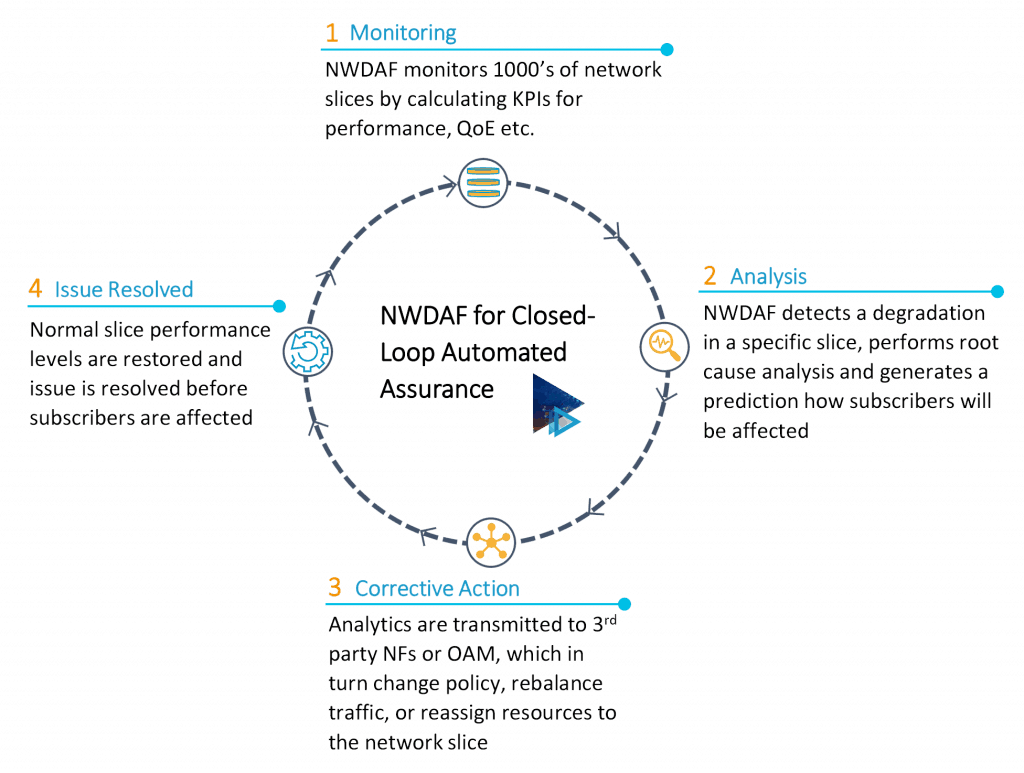Introduction
After years of preparation, commercial 5G has finally gone live in different parts of the world. As of March 2021, 153 operators have launched commercial 5G networks in 64 countries and territories[i]. Moreover, GSA predicted that 3.39 billion subscribers are expected to sign on 5G by the end of 2025[ii].
5G core network is designed to provide innovative capabilities such as Enhanced Mobile Broadband (eMBB), Massive IoT (MIoT), and Ultra-Reliable Low-Latency Communication (URLLC); Catering to everyone from smartphones to robots and advancing mobile technology for years to come.
While previous generations of mobile networks provided basic Quality of Service (QoS) levels for different services, 5G takes this to a whole new level. It is a more adaptive network that is designed to serve diverse industries and enterprises, each with its own different use cases. Such tailored services are enabled through network slicing, one of the key 5G service propositions that divide the network into virtual slices.
Slicing as A New Revenue Opportunity
As operators are investing heavily in their transition to 5G networks, they need to work out ways to generate revenues. According to GSMA, network slicing will be worth USD 300 billion to operators globally by 2025[iii]. Operators can tap into new customers and extend their business array by leasing multiple virtual network slices while still operating from a single physical infrastructure.
Furthermore, network slicing’s flexibility is unprecedented. Multiple slices of different types may be packaged as a single product targeted towards customers who have diverse business requirements. For example, a smart city multiple slice offering can be packaged to answer its different business requirements. From autonomous drones that respond to an emergency, or traffic control that require low latency to ensure real-time responsiveness. Or a mobile broadband slice that provides ultra-high-definition video streaming and fast data rates for fans attending a local sports event. Thus, vertical industries such as utilities, automotive, manufacturing, and AR/VR can all be addressed as commercial ROI opportunities that require their own customized network.
Network Slicing: Tailor Your Network Based on Customers’ Needs
Network slicing enables operators to take the network and divide it up into virtual slices that all run on a common physical infrastructure. Built on a single physical infrastructure, each slice is a single, virtual end-to-end network of its own, that delivers pre-defined network capabilities designed to serve a specific customer’s business purpose. The service quality and SLAs are guaranteed at a per-slice level.
For example, a virtual slice for mobile broadband would guarantee capacity and performance (say for video streaming), whereas a slice for machine-to-machine communications would guarantee connectivity. As the slices are isolated from each other, an error or fault in one slice does not affect other slices’ performance.
Within each network slice, all the components that make up a communication proposition- such as latency, bandwidth, processing power, storage, security model, and others- can all be pre-defined by a customer use case, apportioning every feature and level of functionality of the service offered to meet contracted SLAs. This powers the network to prioritize its resources more efficiently and tailor them based on each customer’s performance, functionality, and operational needs.
Furthermore, while QoS Class Identifiers (QCIs) can differentially treat diverse types of traffic, such as web browsing and VoLTE, it cannot give priority to the same kind of traffic coming from different sources. With 5G network slicing, if the same type of traffic (e.g. live video streaming) is assigned to different slices, it can be treated differently. Thus, network slicing is the cornerstone to a smarter, more flexible network that can be tailored to specific customers’ needs.
The Challenge of Monitoring End-To-End Network Slices
A network slice can span across the network end-to-end, crossing the RAN, edge, transport, and core. While the ability to visualize, monitor, and assure the quality of services across all these domains is indispensable, it presents a significant challenge to operators.
Furthermore, in some use cases, a network may be divided into countless virtual network slices. To guarantee pre-defined SLAs and assure the quality of service, you will be required to monitor and analyze traffic performance KQIs and KPIs for each of these virtual slices. To smartly monitor, manage and optimize each slice, operators will need to deploy an advanced, end-to-end, service assurance solution.
Automated Assurance advantages
The key to 5G network slice assurance is smartly monitoring KPIs and KQIs to understand the overall QoE (Quality of Experience) and QoS and confirm compliance with SLAs. This enables both an automated closed-loop approach to network management and advanced troubleshooting.
Automated assurance is powered by Artificial Intelligence (AI) and Machine Learning (ML) and enables quick and effective validation of network and service performance, isolates network degradations and proactively pinpoints the root cause. Thus, its capabilities include:
- Visibility into your network slices and their QoS/QoE
- Advanced troubleshooting and root cause analysis to find and resolve issues quickly
- Proactive and continuous monitoring of QoE and QoS to confirm SLAs.
- Automated anomaly detection
- Predictive analytics that can forecast issues before they occur
As an additional step towards full network automation, operators can move to a closed-loop approach to 5G network slice assurance by implementing a Network Data Analytics Function (NWDAF).
While most issues can be automatically resolved using the closed-loop approach, some of the most complex issues will still require more traditional tools, such as KPI/KQI dashboards with the ability to drill down to session and packet views for manual deep-dive troubleshooting. Therefore, a comprehensive Service Assurance solution must have both automated and manual options.
NWDAF on every 5G core
Network Data Analytics Function (NWDAF) was first introduced by 3GPP in 2017, and the specifications have been published in 3GPP Releases 15 and 16. NWDAF service consumer NFs, such as Network Slice Selection Function (NSSF) or Policy Control Function (PCF) can query NWDAF for real-time per-slice KPIs/KQIs such as slice load levels and slice QoE measurements or subscribe for network slice-specific notifications that provide periodic updates or anomaly alerts.
The output of NWDAF is then used as input to Policy Control Function (PCF) and Network Slice Selection Function (NSSF). PCF uses that data to optimize its policy decisions, while NSSF uses the data provided by NWDAF to add real-time intelligence to its slice selection algorithms. NWDAF advanced network analytics are delivered over standardized interfaces to other NFs, AFs, and OAM (Operations, Administration, and Management) functions in the network to enable closed-loop automation.
Given the critical role network slicing is expected to play in 5G’s long-term success, all 5G cores should be equipped with NWDAF, which is pointing to the trend of future monitoring that all service providers and assurance solution providers should seriously plan to embrace.
NWDAF for Closed-Loop Automated Assurance
NWDAF continuously monitors and analyzes network slices spanning the RAN, edge, transport, and core network domains. By deploying a next-generation NWDAF’s automated network slice management solution, operators stand to gain advanced 5G network insights, focusing efforts on their data analytics precision.
An automated NWDAF solution continuously monitors a plethora of performance and quality indicators providing advanced analytics to other 5G Core NFs. It can measure subscribers’ quality of experience, from download to upload speeds, and latency to buffering duration for encrypted video streaming. The NWDAF can then utilize each KPI and KQI to detect anomalies that have occurred in the network slice, generating alerts in case of a substantial anomaly from normal values or a deviation from SLAs. By using AI and ML, it can predict the future behaviour of each network slice, therefore triggering an automated closed-loop corrective action that can resolve the issue before it affects subscribers.
NFs and OAM components such as Orchestrators and Cloud Infrastructure Managers (CIMs), use the analytics provided by NWDAF to mitigate current or predicted slice congestion by:
- Connecting new users to alternative slices
- Diverting traffic from congested slices to non-congested slices
- Scaling out or scaling up NF clusters, by snipping up new NF instances or by assigning additional resources to the overloaded network functions.
Hence, an advanced NWDAF solution with built-in AI/ML capabilities, will provide you with automatic, data-driven adjustments and insights not possible to reach through manual network monitoring.
When combined with automated assurance, NWDAF will generate a centralized analytics function that delivers end-to-end network troubleshooting, and complete service and customer experience visibility. Providing operators with an enhanced, more agile network management approach, monitoring and troubleshooting network slices at the service-level, to improve the overall customer experience.

In summary, network slicing is a crucial capability in 5G networks, offering countless new revenue opportunities to operators, whilst providing customers’ guaranteed service quality for diversified use cases. Operators should look for 5G monitoring solutions with a possibility for synergy between the service assurance platform and the new NWDAF. Therefore, providing targeted precision analytics and improving monitoring efficiency, to enable 5G operators to differentiate their service offerings, and deliver on 5G’s big promises.
[i] https://gsacom.com/technology/5g/
[ii] https://gsacom.com/paper/lte-and-5g-subscribers-march-2021-q4/
[iii] Network Slicing, Use Case Requirements. GSMA, April 2018.

